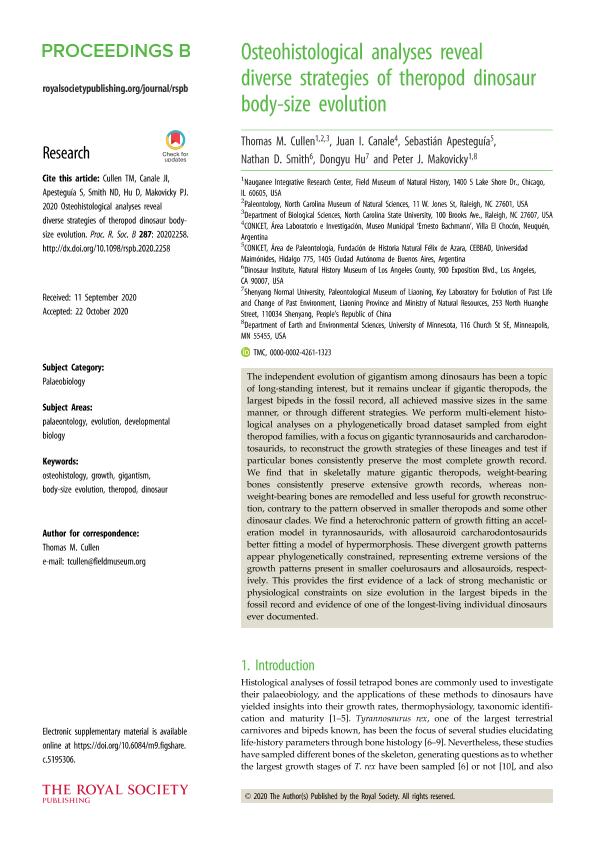Artículo
Osteohistological analyses reveal diverse strategies of theropod dinosaur body-size evolution
Cullen, Thomas; Canale, Juan Ignacio ; Apesteguía, Sebastián
; Apesteguía, Sebastián ; Smith, Nathan D.; Hu, Dongyu; Makovicky, Peter J.
; Smith, Nathan D.; Hu, Dongyu; Makovicky, Peter J.
 ; Apesteguía, Sebastián
; Apesteguía, Sebastián ; Smith, Nathan D.; Hu, Dongyu; Makovicky, Peter J.
; Smith, Nathan D.; Hu, Dongyu; Makovicky, Peter J.
Fecha de publicación:
25/11/2020
Editorial:
The Royal Society
Revista:
Proceedings of the Royal Society of London. Series B: Biological Sciences
ISSN:
0962-8452
e-ISSN:
1471-2954
Idioma:
Inglés
Tipo de recurso:
Artículo publicado
Clasificación temática:
Resumen
The independent evolution of gigantism among dinosaurs has been a topic of long-standing interest, but it remains unclear if gigantic theropods, the largest bipeds in the fossil record, all achieved massive sizes in the same manner, or through different strategies. We perform multi-element histological analyses on a phylogenetically broad dataset sampled from eight theropod families, with a focus on gigantic tyrannosaurids and carcharodontosaurids, to reconstruct the growth strategies of these lineages and test if particular bones consistently preserve the most complete growth record. We find that in skeletally mature gigantic theropods, weight-bearing bones consistently preserve extensive growth records, whereas non- weight-bearing bones are remodelled and less useful for growth reconstruction, contrary to the pattern observed in smaller theropods and some other dinosaur clades. We find a heterochronic pattern of growth fitting an acceleration model in tyrannosaurids, with allosauroid carcharodontosaurids better fitting a model of hypermorphosis. These divergent growth patterns appear phylogenetically constrained, representing extreme versions of the growth patterns present in smaller coelurosaurs and allosauroids, respectively. This provides the first evidence of a lack of strong mechanistic or physiological constraints on size evolution in the largest bipeds in the fossil record and evidence of one of the longest-living individual dinosaurs ever documented.
Palabras clave:
OSTEOHISTOLOGY
,
GROWTH
,
GIGANTISM
,
BODY-SIZE EVOLUTION
,
THEROPOD
,
DINOSAUR
Archivos asociados
Licencia
Identificadores
Colecciones
Articulos(CCT - PATAGONIA CONFLUENCIA)
Articulos de CTRO.CIENTIFICO TECNOL.CONICET - PATAGONIA CONFLUENCIA
Articulos de CTRO.CIENTIFICO TECNOL.CONICET - PATAGONIA CONFLUENCIA
Citación
Cullen, Thomas; Canale, Juan Ignacio; Apesteguía, Sebastián; Smith, Nathan D.; Hu, Dongyu; et al.; Osteohistological analyses reveal diverse strategies of theropod dinosaur body-size evolution; The Royal Society; Proceedings of the Royal Society of London. Series B: Biological Sciences; 287; 1939; 25-11-2020; 1-9
Compartir
Altmétricas



